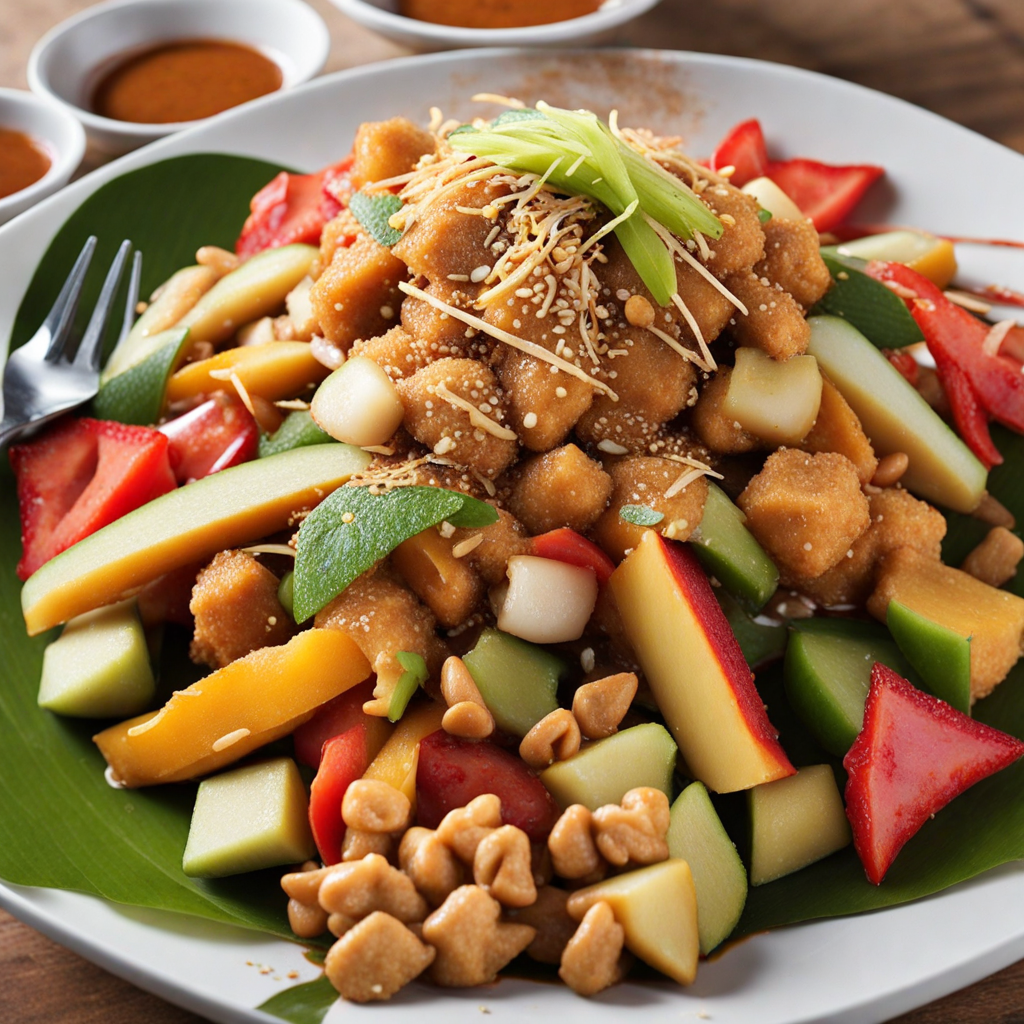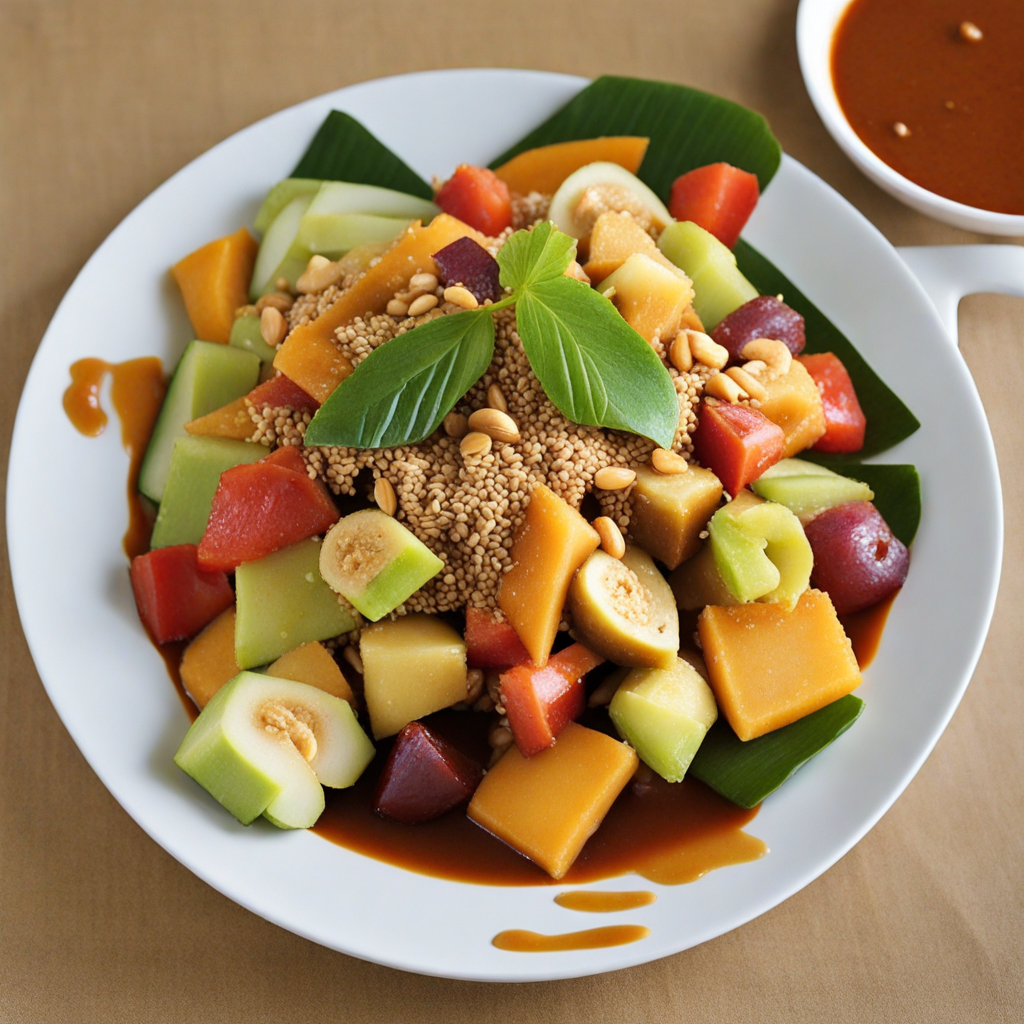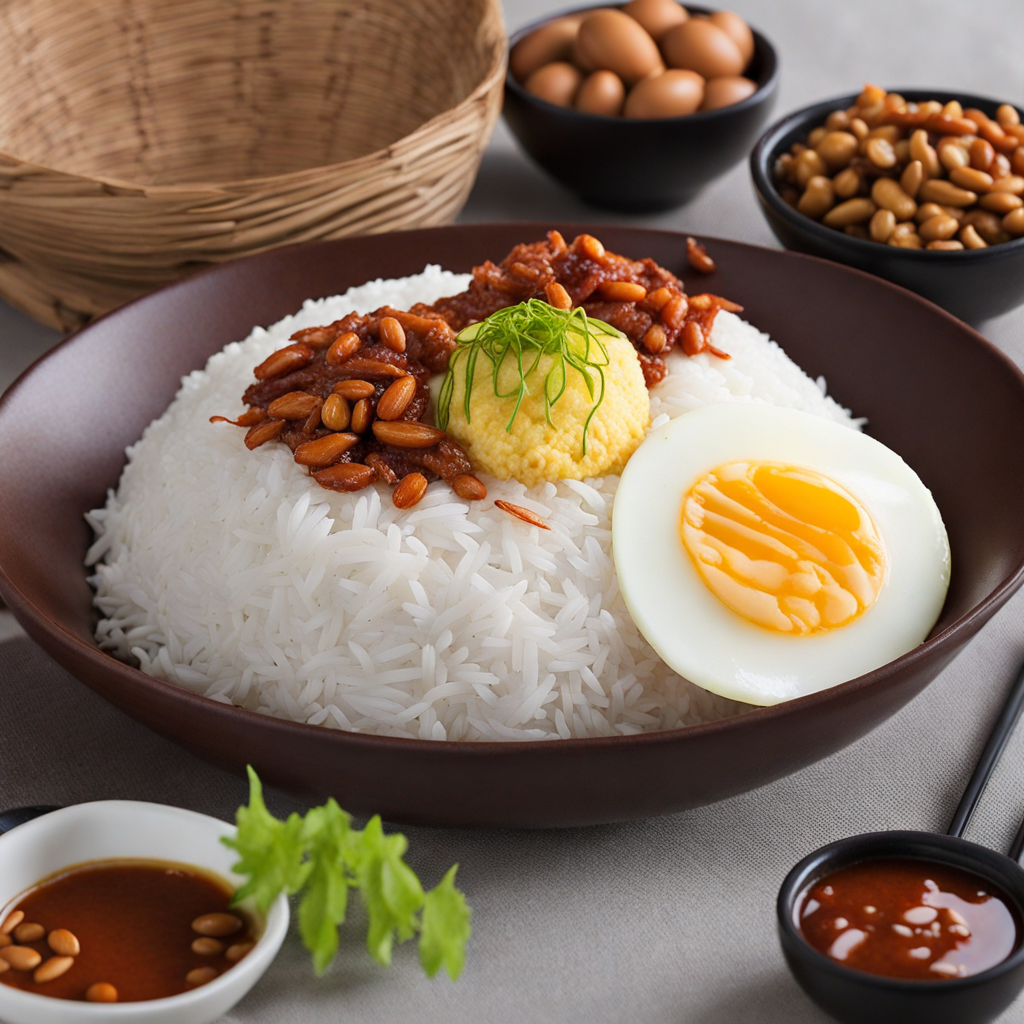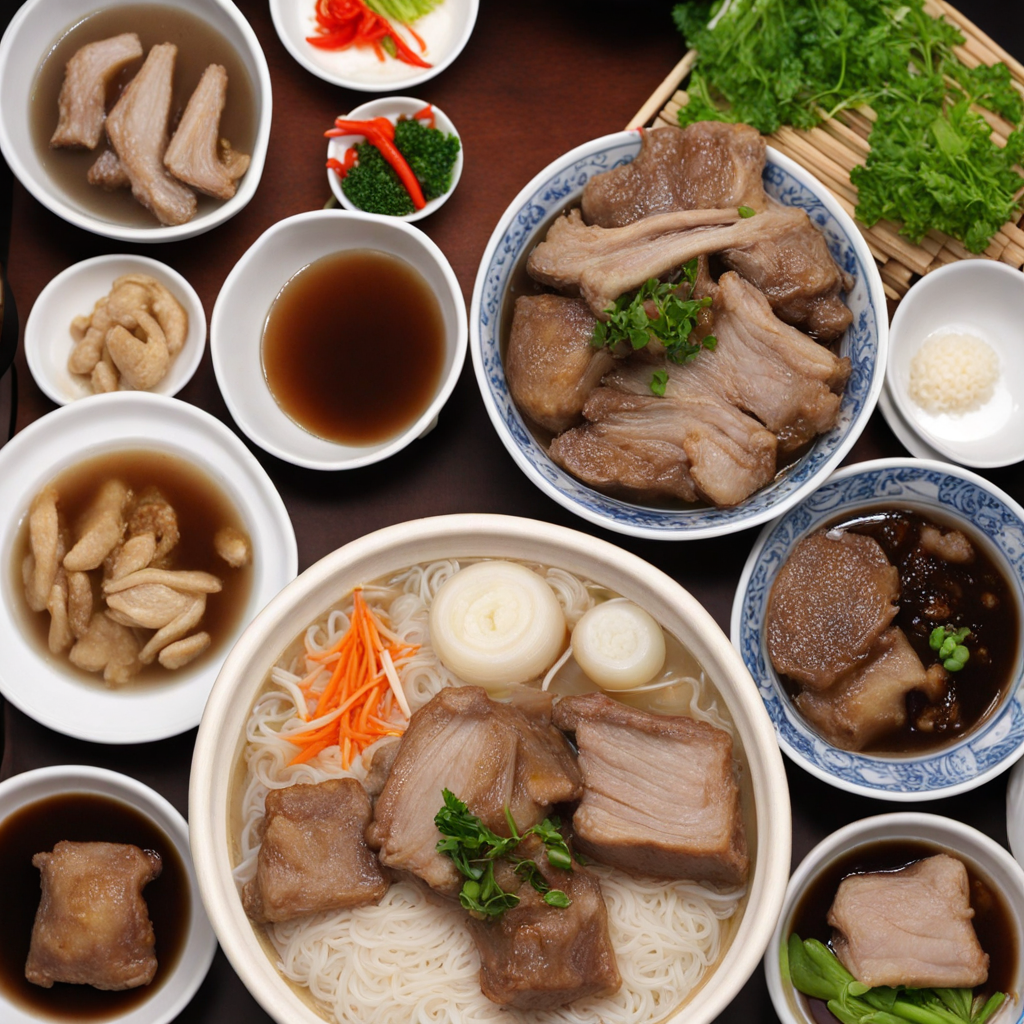Rojak
Rojak is a vibrant and tantalizing salad that hails from Singapore, showcasing a unique blend of flavors and textures that reflect the multicultural fabric of the city-state. At its core, Rojak combines a medley of fresh fruits and vegetables, typically including crisp cucumber, juicy pineapple, and crunchy jicama, all tossed together in a luscious dressing. The dressing is a rich concoction made from tamarind, shrimp paste, sugar, and chili, creating a delightful balance of sweet, savory, and tangy notes that dance on the palate. This dish is not just a salad; it's an explosion of taste that invites you to savor each bite. The beauty of Rojak lies in its versatility, as it can be tailored to suit various preferences. Some versions incorporate additional ingredients such as bean sprouts, fried tofu, and even hard-boiled eggs, adding layers of flavor and a satisfying heartiness to the dish. Another popular variation is the "Rojak buah," which focuses primarily on fruits like mango, apple, and banana, offering a refreshing twist that is perfect for warm weather. Each component contributes to a delightful crunch, making Rojak a textural delight as much as a flavorful one. Enjoying Rojak is an experience in itself, often served as a street food snack or a side dish at local eateries. As you dig into this colorful dish, you'll discover the interplay of sweet, spicy, and umami flavors that truly define Singaporean cuisine. Whether you're a fan of bold flavors or seeking something new to excite your taste buds, Rojak is sure to leave a lasting impression, inviting you to explore further into the rich culinary heritage of Singapore.
How It Became This Dish
The Engaging History of '罗惹' (Rojak) from Singapore Rojak, a vibrant and flavorful dish, is a quintessential part of Singapore's culinary tapestry. This fruit and vegetable salad, characterized by its unique blend of sweet, spicy, and tangy flavors, reflects not only the multicultural essence of Singapore but also its historical roots and evolution over time. The name "rojak" itself means "mixture" in Malay, encapsulating the very spirit of this dish that brings together diverse ingredients, much like the people of Singapore. #### Origins of Rojak The origins of rojak can be traced back to the Malay Archipelago, where the dish was traditionally made using local fruits and vegetables. The word "rojak" is derived from the Malay language, which highlights its Malay roots. Traditionally, it was prepared with a mix of fruits such as cucumber, pineapple, jicama (also known as bengkuang), and sometimes even mango. The salad was then dressed with a sauce made from shrimp paste (belacan), tamarind, sugar, and chili, creating a distinctive and indulgent flavor profile. The dish has ancient roots, often consumed by various ethnic groups in the region, including Malays, Chinese, and Indians. Each community added its own twist to the recipe, contributing to the rich tapestry of Singaporean cuisine. The Chinese version of rojak, known as "you tiao rojak," incorporates deep-fried dough fritters (you tiao) and is typically served with a thicker, sweeter sauce. Meanwhile, the Indian variant, particularly popular among the Indian Muslim community, features a combination of fruits and vegetables tossed in a spicy sambal sauce, often accompanied by peanuts. #### Cultural Significance Rojak's cultural significance extends beyond its culinary appeal. It symbolizes the multicultural identity of Singapore, where various ethnicities coexist and influence one another's culinary traditions. The dish is often enjoyed as a snack or appetizer, making it a common feature at hawker centers, food courts, and street stalls throughout the city-state. In many ways, rojak serves as a microcosm of Singapore itself—a melting pot of flavors, cultures, and traditions. It represents the harmonious blending of different communities, showcasing how food can transcend cultural barriers. This dish is particularly popular during festive occasions and gatherings, as it brings people together to share in the joy of diverse flavors and experiences. The practice of making rojak has also become a social activity. Families and friends often come together to prepare the dish, fostering bonds and creating shared memories. The act of mixing ingredients, drizzling the sauce, and garnishing with crushed peanuts and sesame seeds is often an interactive experience, making it a communal affair. #### Development Over Time As Singapore evolved into a cosmopolitan hub, so too did its culinary landscape. The introduction of new ingredients and cooking techniques has led to the transformation of traditional rojak into various modern interpretations. Today, one can find an array of rojak variations reflecting the city's dynamic food scene. In the late 20th century, with the rise of globalization and the influence of international cuisines, chefs began experimenting with rojak, incorporating unconventional ingredients and flavors. For instance, some hawkers now offer fusion versions of rojak, integrating elements from Western cuisine or even Japanese influences, such as using wasabi or sushi ingredients. This innovation has kept the dish relevant and appealing to younger generations, who are eager to explore new tastes while honoring traditional roots. The advent of social media has also played a role in the evolution of rojak. Food bloggers and influencers have showcased their rojak creations online, prompting a resurgence of interest in this beloved dish. The visual appeal of rojak, with its colorful array of fruits and vegetables, has made it a popular subject for Instagram feeds, further cementing its status as a must-try delicacy in Singapore. #### Rojak in Contemporary Singapore Today, rojak remains a staple in Singapore's hawker culture, representing the country’s culinary heritage. It can be found in various forms, from traditional stalls to modern eateries. Many hawkers pride themselves on using fresh, high-quality ingredients, ensuring that the integrity of the dish is maintained while also adapting to contemporary tastes. One of the most popular places to enjoy rojak is at the famous Lau Pa Sat hawker center, where patrons can savor a variety of versions from different vendors. The bustling atmosphere, combined with the enticing aroma of rojak being prepared, creates an authentic culinary experience. In addition, rojak has found its way into various food festivals and culinary competitions, where chefs showcase their creative interpretations of the dish. This not only highlights the versatility of rojak but also encourages culinary innovation among aspiring chefs and food enthusiasts. The continued popularity of rojak is a testament to its significance in Singapore's food culture. With each bite, one can taste the history, the melting pot of cultures, and the spirit of innovation that defines this dish. Whether enjoyed as a late-night snack, a refreshing appetizer, or a festive treat, rojak remains a beloved part of Singapore's gastronomic identity. #### Conclusion Rojak is more than just a dish; it is a celebration of Singapore's rich cultural heritage and its evolution over time. As a symbol of unity and diversity, it embodies the essence of a nation that thrives on the interplay of flavors, traditions, and communities. From its humble beginnings in the Malay Archipelago to its contemporary interpretations in the bustling hawker centers of Singapore, rojak continues to captivate the hearts and palates of locals and visitors alike. In an ever-evolving culinary landscape, rojak stands as a reminder of the importance of preserving traditions while embracing innovation. It invites us to explore the beauty of diversity, one delicious bite at a time. As Singapore's food scene continues to flourish, rojak will undoubtedly remain a cherished staple, proudly representing the nation's culinary legacy for generations to come.
You may like
Discover local flavors from Singapore







